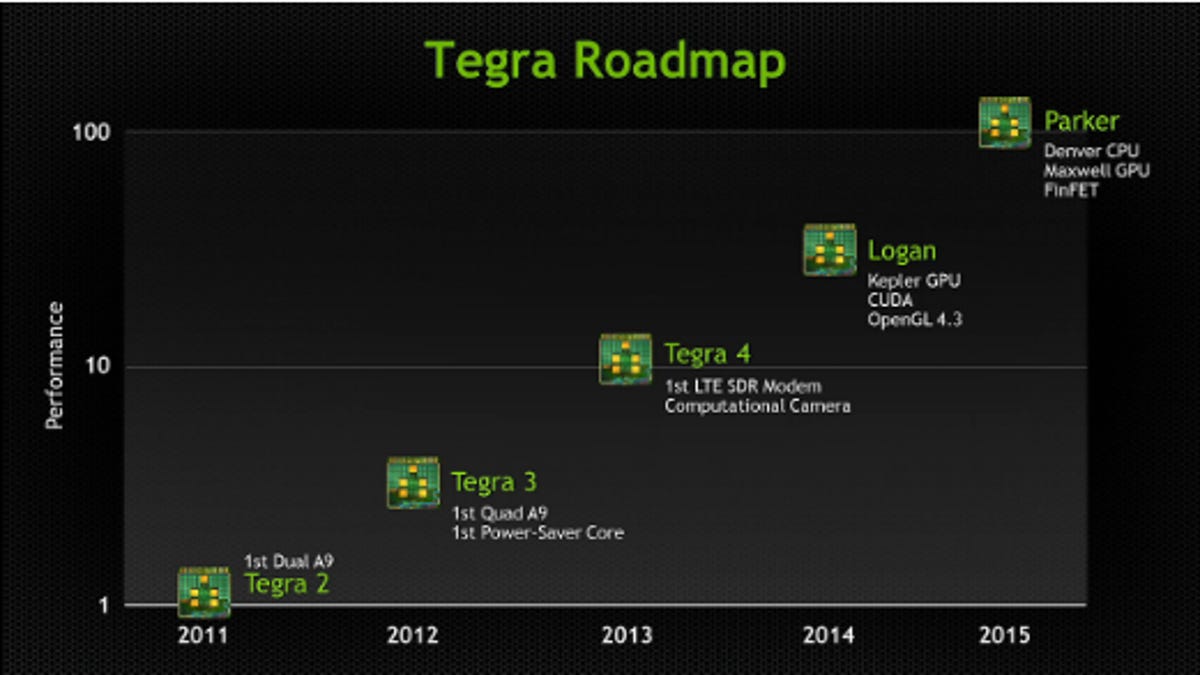Nvidia CEO unveils next two gens of Tegra, dubbed Logan, Parker
Jen-Hsun Huang says the company's mobile chip will show 100-times improvement from the first generation to the fifth.

Logan will incorporate Nvidia's Kepler GPU, which currently is dominating the discrete graphics market. It also will include CUDA, Nvidia's programming model for GPUs that allows users to do many tasks at once.
Parker, meanwhile, will be Nvidia's first processor from its Project Denver push. That includes full 64-bit capabilities, making it more attractive for use as the brains in one's computer or in a server or supercomputer. Nvidia first started talking about Project Denver during the Consumer Electronics Show in 2011, but it hadn't provided many updates since that time.
Parker also will incorporate a Maxwell GPU, Nvidia's next-generation architecture.
"In five years time, we'll increase Tegra by 100 times," Huang said. "Moore's Law would suggest an eightfold increase."
Huang also unveiled Kayla, a development platform for CUDA and OpenGL, an API for rendering 2D and 3D computer graphics. Kayla is powered by the Tegra 3 quad-core ARM processor and a next-generation Kepler GPU. It will be available this spring from ARM-based PC providers.
Nvidia today is hosting its GPU Technology developers conference. Traditionally known for making graphics processing units found in computers and game consoles, Nvidia has been counting on its Tegra mobile chips to help offset weakness in its core PC market. So far, it hasn't been enough. Its presence in smartphones has been minimal, and the bulk of Tegra sales are for a couple of tablets, the Google Nexus 7 and the Microsoft Surface. In addition, Nvidia now is facing more competition in the tablet market.
Meanwhile, Huang today also unveiled Nvidia's next-generation GPUs. The Kepler architecture, which is currently shipping in devices, will be followed by Maxwell in 2014. That architecture has a unified virtual memory that makes it possible for GPU operations to read and see the CPU memory, and vice versa. All memory is visible to all processors. That's going to make it easier for developers, Huang said.
Volta comes next. That GPU will have a new technology called stacked memory. Nvidia said it will solve one of the biggest challenges today, which is memory bandwidth for GPU. Volta will take a leap forward and will stack the DRAM on the same silicon substrate. It will carry DRAMs stacked on top of one another.
"I love that name, because it would suggest that Volta will be even more energy-efficient," Huang said.
Huang also introduced the GRID "Visual Computing Appliance," which is designed to let businesses deliver ultrafast GPU performance to any Windows, Linux, or Mac client on their network.
GRID VCA enables businesses to house graphics-intensive tasks in the cloud. Nvidia noted that it provides "enormous flexibility to small- and medium-size businesses with limited IT infrastructures." Employees are able to create virtual machines with dedicated, high-performance GPUs.
CNET's Jessica Dolcourt contributed to this report.
Update, 12:45 p.m. PT: Adds details about Kayla and GRID Visual Computing Appliance.

